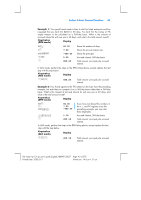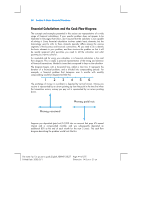HP 113394 User Guide - Page 46
The Cash Flow Sign Convention
 |
UPC - 808736340502
View all HP 113394 manuals
Add to My Manuals
Save this manual to your list of manuals |
Page 46 highlights
46 Section 3: Basic Financial Functions z FV - the future value - is the final cash flow or the compounded value of a series of prior cash flows. In the particular problem illustrated above, FV is unknown (but can be calculated). Solving the problem is now basically a matter of keying in the quantities identified in the cash flow diagram using the corresponding keys, and then calculating the unknown quantity by pressing the corresponding key. In the particular problem illustrated in the cash flow diagram above, FV is the unknown quantity; but in other problems, as we shall see later, n, i, PV, or PMT could be the unknown quantity. Likewise, in the particular problem illustrated above there are four known quantities that must be entered into the calculator before solving for the unknown quantity; but in other problems only three quantities may be known - which must always include n or i. The Cash Flow Sign Convention When entering the PV, PMT, and FV cash flows, the quantities must be keyed into the calculator with the proper sign, + (plus) or - (minus), in accordance with ... The Cash Flow Sign Convention: Money received (arrow pointing up) is entered or displayed as a positive value (+). Money paid out (arrow pointing down) is entered or displayed as a negative value (-). The Payment Mode One more bit of information must be specified before you can solve a problem involving periodic payments. Such payments can be made either at the beginning of a compounding period (payments in advance, or annuities due) or at the end of the period (payments in arrears, or ordinary annuities). Calculations involving payments in advance yield different results than calculations involving payments in arrears. Illustrated below are portions of cash flow diagrams showing payments in advance (Begin) and payments in arrears (End). In the problem illustrated in the cash flow diagram above, payments are made in arrears. Regardless of whether payments are made in advance or in arrears, the number of payments must be the same as the number of compounding periods. To specify the payment mode: z Press g× if payments are made at the beginning of the compounding periods. z Press g if payments are made at the end of the compounding periods. File name: hp 12c pt_user's guide_English_HDPMF123E27 Page: 46 of 275 Printed Date: 2005/8/1 Dimension: 14.8 cm x 21 cm















